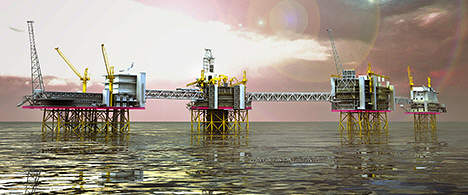|
Statoil: The gigantic Johan Sverdrup field,
one of the most
profitable industrial projects in Norway over coming decades,
will provide
enormous value.
Nov 3, 2014
+ + + Construction of the
first phase may lead to 51,000 man-years related to Norwegian deliveries,
and the field may produce revenues amounting to NOK 1350 billion. The
project will provide new knowledge, new solutions and new opportunities.
“Johan Sverdrup represents all we stand for as
an industry and our faith in the future. This will be a gigantic project
that will secure energy supply and jobs and result in substantial
spin-offs and value for Norwegian society, the industry and the
partnership behind the development,” says Nylund.
Johan Sverdrup is one
of the biggest discoveries on the Norwegian continental shelf since the
mid-1980s and ranks among the biggest developments in the years ahead.
The consultation
period concerning the environmental impact assessment for the field and
the power proposal will now commence.
Large Norwegian
component
It is estimated that the first-phase
development of the Johan Sverdrup field will create around 51,000
man-years nationally, of which as many as 22,000 are expected to be
performed by suppliers in Norway and approx. 12,000 by their
subcontractors.
Calculations show that 2,700 man-years will be
created in an average year in the production phase, with 3,400 man-years
expected to be created at peak field development.
Based on estimates
from Agenda Kaupang it is possible for the Norwegian supplier industry to
be awarded more than 50% of the assignments in the construction phase and
around 90% in the operating phase.
“It is very important
for the Johan Sverdrup development that the Norwegian supplier industry
positions itself well for the opportunities lying ahead,” says Nylund.
A new chapter
According to a
provisional estimate, total production revenues over 50 years may amount
to as much as NOK 1350 billion. Of this amount, corporation tax alone
will give the Norwegian state NOK 670 billion in direct revenue. Total
investments for the first development phase are NOK 100-120 billion,
while production will be in the range of 315,000-380,000 barrels per day.
Looked at from the
perspective of 50 years, Johan Sverdrup will be a long-term project that
several generations will bring to maturity and operate. The 200 sq.km.
large field will be developed in stages. The partners are currently
working on various development scenarios for the various phases in order
to ensure that the first construction phase forms the basis for an
overall, integrated development.
“We are planning for a
stepwise field development with various installations tied back to a joint
field centre. This will ensure continuity and comprehensive resource
utilisation and also generate the greatest possible added value for our
owners,” adds Nylund.
Depending on the
future choice of capacities and technical solutions, an early estimate for
full development indicates NOK 170-220 billion with daily production put
at 550,000-650,000 barrels per day.
Johan Sverdrup is
situated in mature acreage that has been thoroughly studied and where the
most central environmental aspects are that the development receives its
power from land; that produced water will be purified and re-injected into
the reservoir; and that cuttings drilled with oil-based liquid will either
be brought ashore, or purified and discharged offshore. This is in
accordance with regulations and a permit will be applied for.
The environmental
impact assessment forms part of the plan for development and operation
that is expected to be handled by the Storting next year and expected to
be prepared and agreed by the partners in the beginning of February 2015.
Environmental impact
assessment
An important milestone for the first planning
phase of the comprehensive field development has been reached: The
environmental impact assessments of: the field; the power solution; and
the export solutions, are ready for consultation.
This is the first part
of the plan for development and operation (PDO), the plan for installation
and operation (PIO) of the power transmission facilities and the plan for
installation and operation (PIO) for the export solutions respectively.
They will be submitted
to the Ministry of Petroleum and Energy (MPE) in the beginning of 2015 to
be discussed by the Norwegian parliament (the Storting). An investment
decision will also be made at that time. Production start-up is scheduled for the fourth
quarter of 2019.
Source: Statoil -
www.statoil.com
|

Worldwide more than
90,000 paid subscriptions

Worldwide
more than 48,000 subscriptions -
100% one-year direct request
qualification

'What's New' in Upstream, Midstream and
Downstream Products & Services. Circulation 37,000
PennWell
Petroleum Group:
Oil & Gas Journal
Oil & Gas Journal Russia
OGJ_eNewsletter
OGJ-Website-Statistics
Oil, Gas & Petrochem Equipment
Offshore Magazine
Offshore
Russia
Offshore eNewsletter
Offshore
Website Statistics
Oil & Gas Financial Journal
+ + +
For more information, media
kits or
sample copies please contact
Andreas
Sicking
+49 (0)2903-338570
wilhelms@pennwell.com
www.sicking.de
|


